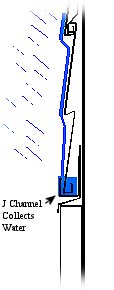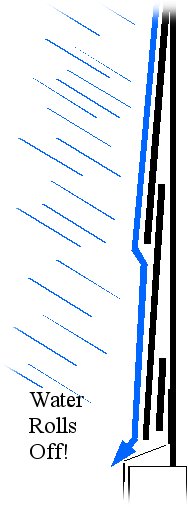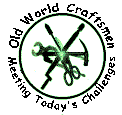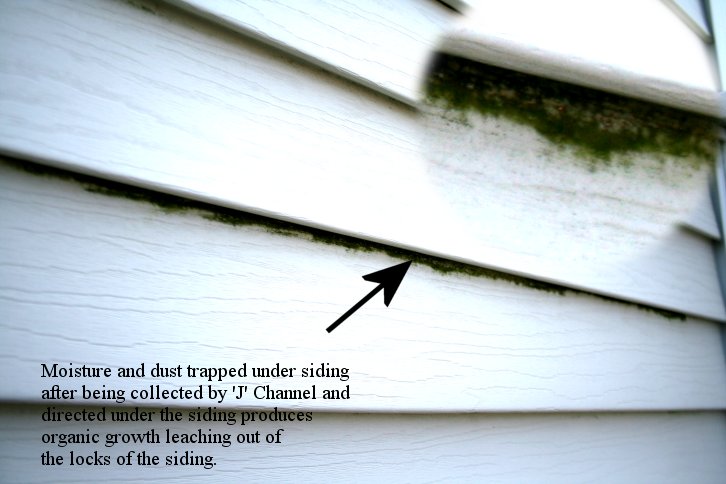Steel Siding,
Aluminum Siding, and Vinyl Siding come in several configurations
but they all have one major flaw in design. That flaw is
in the use of water collecting ?J? Channels.
Decades ago, the metal exterior cladding products brought
the ?J? Channel to the fore for exterior trades.
These channels were thin and low profile, but the inherent
problems with leaks were evident to the tradesmen that followed
the exterior cladders. 'J' channels are even
improperly used on Fiber Cement Siding!
Note: The
actual examples below are not indicative of every siding
job with 'J' Channels. All photos below are from the
same area on the same wall of one house. This is the
northeast side of a home located about 2 blocks from the
NJ shore. This is an extreme example of what can happen
on an open, and unprotected wall without overhangs.
 |
The use
of these 'J' Channels has long been helpful in interior
applications, such as drywall and interior cladding terminations.
Materials could be cut, capped, and butted cleanly to adjoining
materials in a neat, fast, and appealing application. This
idea has been inappropriately applied to exterior wall cladding
construction. Look at the photo to the left:
A common problem is the water that is trapped behind the
siding from the velocity resulting from water collecting
'J' Channel on a round window. Large Patio Doors
are also a problem with the width of the water
collecting 'J' Channel. Rain water is collected
and directed behind the siding, along with any dust or
material that resided on the wall. |
 |
|
The
focus of siding installations has mostly been on aesthetics
and functionality was something that was left for
the subsequent service call. Leaks in siding, as we
have documented on this website several times, are
usually not realized right away.
Many damaging affects
of the use of the water collecting ?J? Channels have
been realized years after initial installation. When
mold, insect infiltration, and rot have taken over,
walls can begin to stink, structures can begin to
sag, in extreme circumstances, and insects have a
field day. |
 ? ? |
J?
Channels cause water to enter behind the siding, along
with any dust that may be present on the wall.
Dust, along with the organic components of the wall
substrate can become food for an organism that may
have been harmless while on the surface of the siding. |
These photos of organic growth resulted from the
accumulation of moisture and dust that washed
behind the siding at the window and door heads and
down the channels and into the locks. The overflow
of material and organic growth shows itself
seeping out at the locks. Mold and mildew thrive
in warm and moist environments. |
|
|
|
| MOLD SPORES |
|
 |
|
The use
of ?J? Channels to hide the expansion and contraction provisions
in the Siding itself has made for even larger channels. The channels
are made very large, because the gaps in the siding left
for thermal movement are large. A 1? ?J? Channel is now
the norm, and this replaces the smaller channels of old.
Larger channels mean more water collection. The vertical
walls of a home shed enormous amounts of water in the face
of a storm. Many gallons of water flow down the vertical
surfaces to meet the penetrations in the vertical planes:
Window and Door Heads are normal obstructions to this massive
flow of rain water. Just like a gutter on every window
and door,
these water collecting channels collect the rain water and
channel it behind the siding. Now Seamless Siding has hit
the scene with even larger expansion rates and larger channels. The bigger the ?J? Channel, the bigger the
water retention and leaks associated with this
methodology. |
| |
|
 |
|
|
 |
Some in the industry claim that all that is required is an underlayment that will keep the water out of the substrate after it has entered behind the siding.? This can be the case, but for how long? Below we have a link to the ?Weather Barrier Statement.?? This statement, made in writing by the Vinyl Siding Institute, and makes it very clear that if you have siding installed with ?J? channels on your home, underlayment must be used to keep the rain water out of your home.
The major push for housewraps and weather barriers has been largely caused by the industry that has been put on notice regarding the expectation of precipitation entry under the siding. This is sometimes a big mistake if the entire wall system is not first considered, especially on older homes. This crazy dilemma is, in part, caused by ignorance. Part of the onset of the problem was in the mindset that came with the cover-all mentality. With little experience and minimal tools, a newcomer could start out covering over existing homes in a neighborhood in a seemingly harmless endeavor of exterior ?upgrades.? In many cases, and years after these products are installed; however, the real damage is realized. The siding, along with the underlying materials must be removed in order to gain access to the rotting structure of the home. Manufacturers have notified the trades with the "Weather Barrier Statement" and the designation of the siding as only a "Supplemental Rain Screen."The installer of your siding is on the hook if the siding job leaks, if he can be found.?? |
|
|
|
A simple answer is not to use any product that ?bucks water.? Bucking water is an age old roofing term that, essentially, means that materials should be lapped as to allow the flow of water off of the plane of the roof and flashing details. Why has this simple truth been abandoned in much of the Siding Industry? |
Below is a new age window with incorporated channels, manufactured for "easier" installation.? |
 |
 |
The photo to the left shows
a proper window trim application. This is a simple,
low-tech application, just like the true tradesmen of old
used to employ. No ?J? Channel is used in a true
watershed application that disperses rain water & debris
off the building. |
 |
|
Read about Mold behind Siding caused by interior moisture, house wrap and new age paint. |



 ?
?





